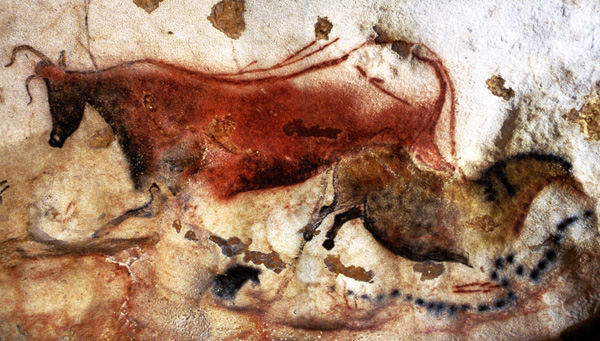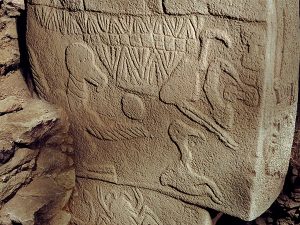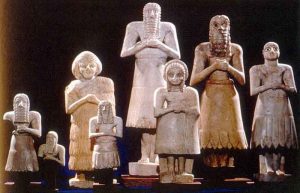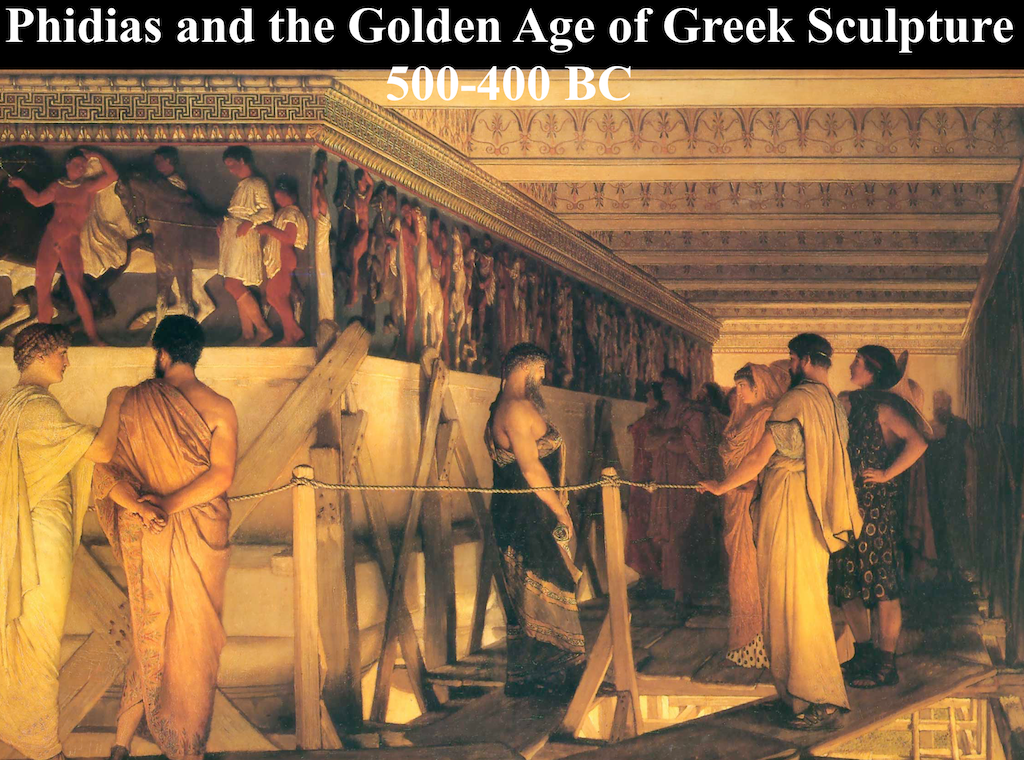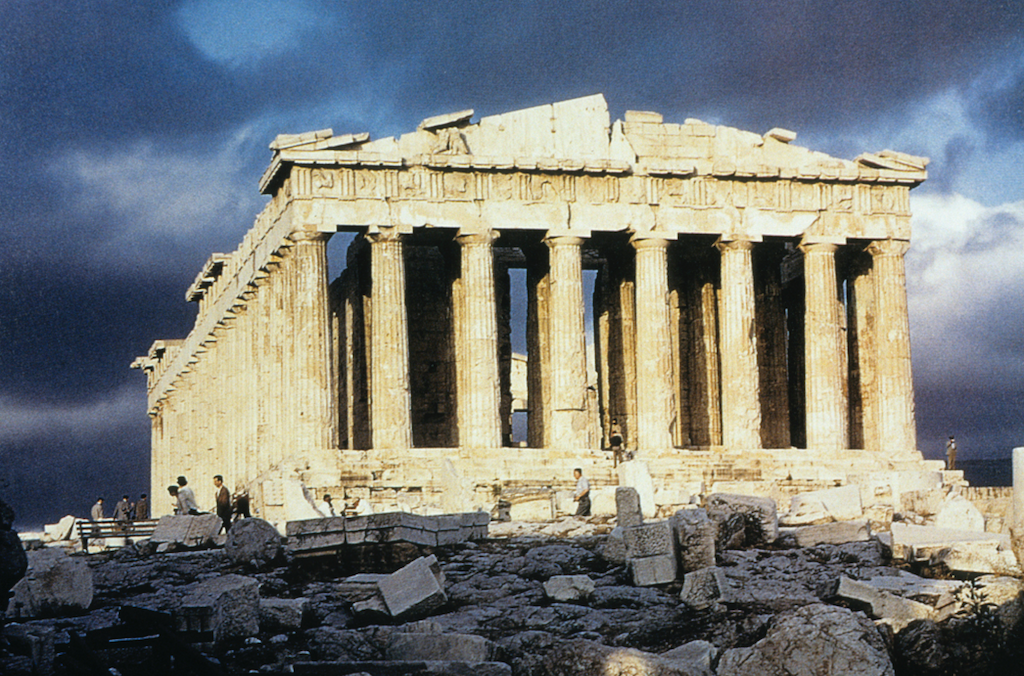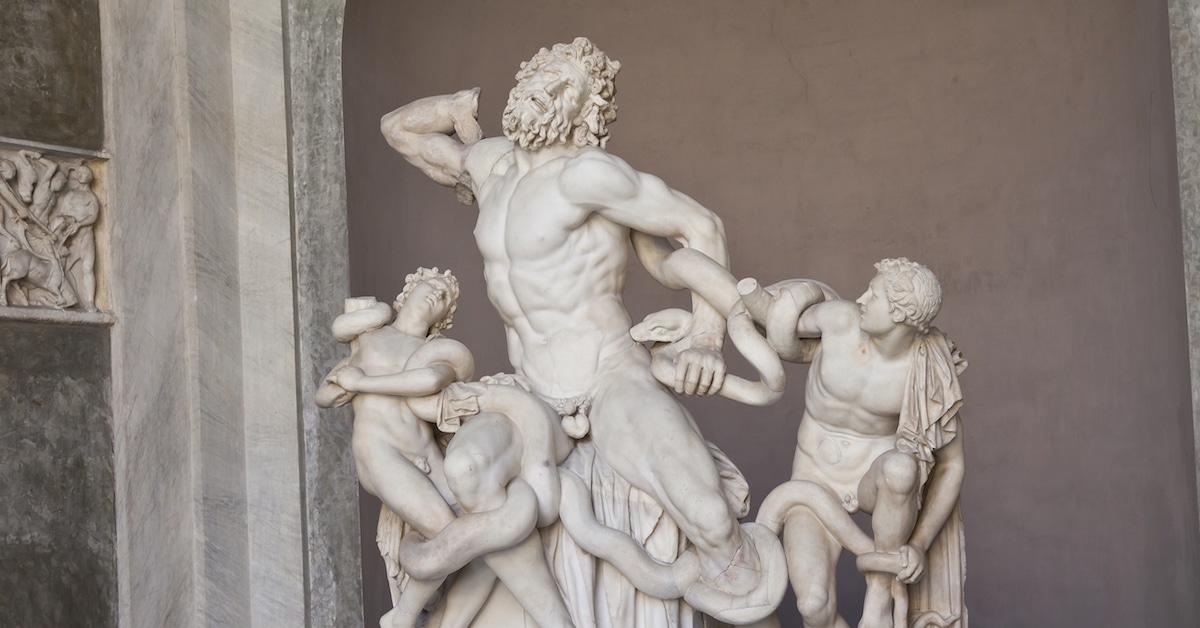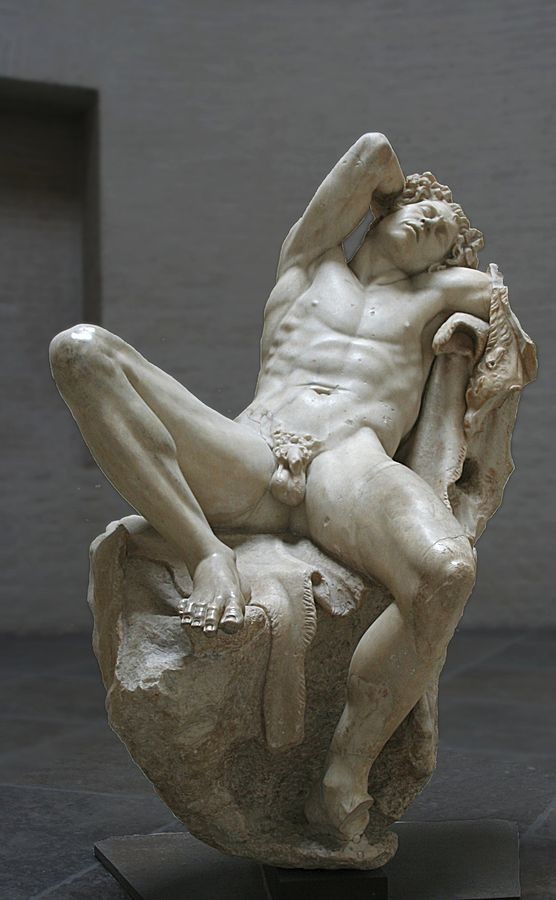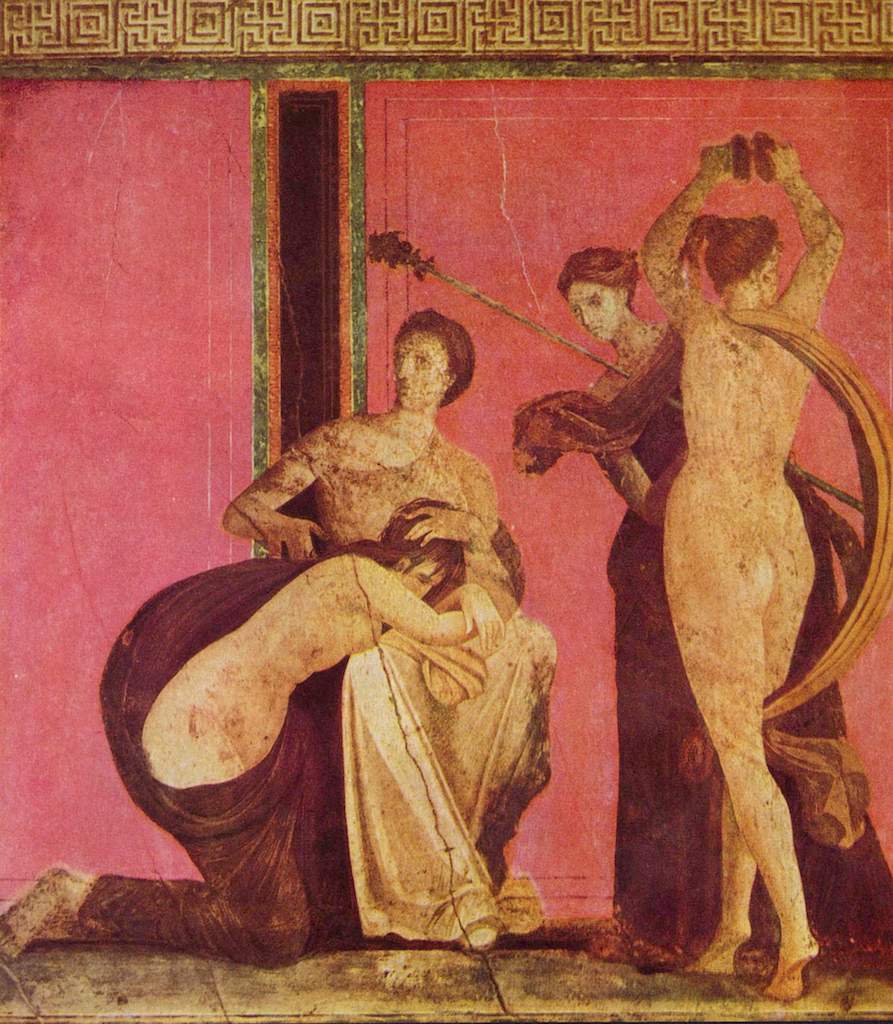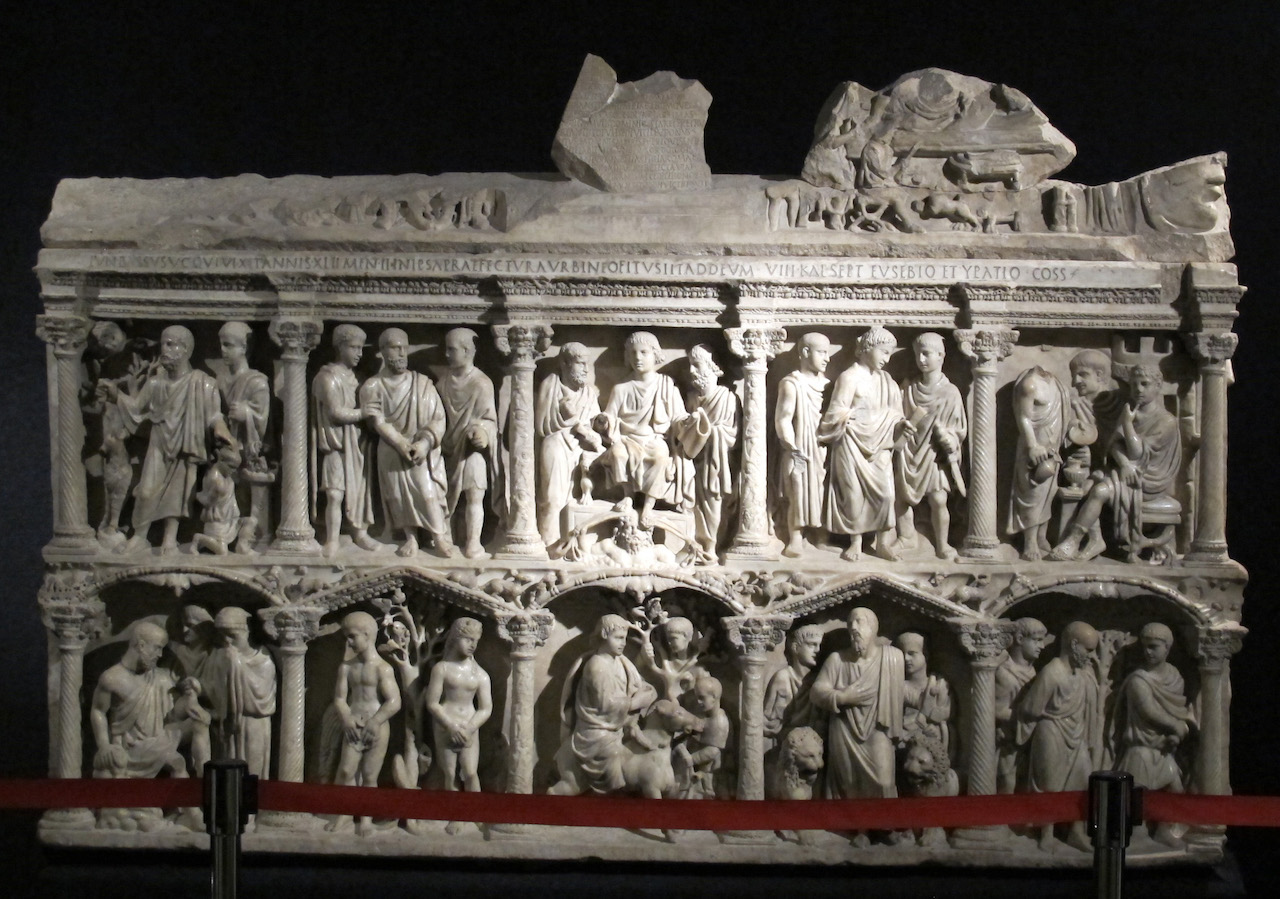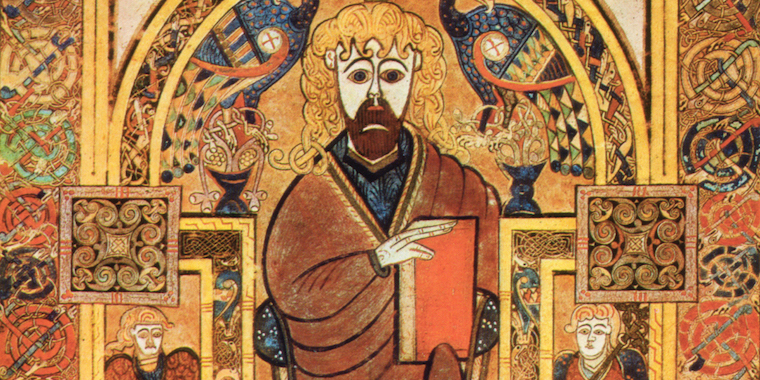Week 1
Week 1: Wednesday, October 12, 2022
The Necessity of Art
Week 1
Human beings cannot live without art. They never have. The caves at Lascaux date back to possibly 30,000 years BC. They demonstrate that before agriculture, before the domestication of animals, people on earth created works of art. At Goeblecki Tepe, at Skara Brae on the Orkney Islands, or in the Egyptian desert, all over the world at all times, human beings have turned to some kind of artistic expression of who they are. Our first records of human life comes from their art. All human beings have made art. Human beings live painful, difficult lives and art allows them to escape that pain as well as allowing them to find fulfillment, meaning and even a kind of mystical union with the forces of nature. Art is a human creation. It is part of the human world. Animals do not care about art with one exception: music. Cows love Bach and give more milk with Bach. Chickens hate rock and rap and produce speckled eggs showing their discomfort with the nasty loud noise of contemporary rap. Monkeys made art only for bananas. They did not really care about art. Art is of the human world.
Our thirty weeks will allow us to see what this artistic world looks like.
REQUIRED READING
We are offering this book title to you as a "Required" book, but of course if you're schedule does not allow more reading then you can save this for later. What the author has done, a Professor of Philosophy at Columbia University, so to write a short book of about 100 pages in which he attempts to tell you why we need art, what art does, and what the relationship is for the human being and the arts. It is the best all-around introduction to the field of aesthetics that anyone has written since Aristotle.
RECOMMENDED READING
If you want the book above just click on the icon of the book and it will take you to that book within the Amazon catalog.
We want one book that will serve us all year for general background to both art and history. There are tow very famous ones, Helen Gardner and H. W. Janson. Both Janson and Gardner have been used in universities for art surveys for decades and because of this the price and availability of both volumes has now surpassed 100$ for a new copy of either. And used copies are very hard to get because university undergraduates have snapped them up every year. So all of this brings us to Hugh Honour. Honour was a very great British art historian who lived most of his life in Italy. He wrote many good books and along the way he wrote one of the very best one-volume surveys of art that now turns out to be the best choice for us. It is beautiful, not outrageously overpriced, and available. I have printed a screen shot of the page from Amazon to point out that you must be careful. You do not want to "rent" the book. That is very cheap undergraduates. And as you can see there are many options in the price category. A brand new one is about 70$ and we just received several at the Institute and they were perfect. It is a very beautiful especially since it has on its cover the magnificent Simonetta Vespucci.
2
Week 2: Wednesday, October 19, 2022
Art in the Ancient World: Egypt, Mesopotamia, India, and China
Week 2
The story that we will follow here these next ten weeks of Fall Quarter is the story of Western Art, that is, art that begins in Ancient Greece, continues on into Roman civilization and then on into Medieval Europe. But there are many important artistic traditions that anticipate the Western story by thousands of years. We will explore those other, older artistic traditions this week. It is a. fleeting moment to spend with such artistic richness, but it will possibly spark an interest in something you do not know, and you can return to it later. We do not know what is the oldest of Mediterranean artistic traditions. For a hundred years. we have assumed that art began in Sumer at something like 3000 BC. But with the discovery of Göbekli Tepe in Turkey in 1994 by Klaus Schmidt of the German Archaeological Institute in Turkey, those boundaries had to be moved back to ten thousand BC.
RECOMMENDED READING
For week two of History of Art, read the first 100pp of Honour.
Ancient Egypt, Mesopotamia, Minoans, India, China.
3
Week 3: Wednesday, October 26, 2022
Early European Art
Week 3
The roots of all of Western art were laid down in the momentous invasions of the Indo-European peoples into the Mediterranean area in about 2000 BC. These invasions that we now refer to as the Indo-European Invasions brought a new people into the Mediterranean world, people with horses and chariots and a completely new culture. They came with chariots from the Ukraine and Russian steppe region. The culture they brought with them was the basis for the new societies in Greece, Italy, and Central Europe.
RECOMMENDED READING
4
Week 4: Wednesday, November 2, 2022
The Art of Agamemnon and Nestor
Week 4
The earliest manifestation of the new Bronze Age invader culture is visible in the art of Mycenae (Agamemnon), Pylos (Nestor) and Troy (The treasure of Priam). All three of these ancient Greek city-states were established and rich by 1500 BC and all three are connected in the stories of the Trojan War which is often dated to something like 1200-1100 BC (same time as the Exodus). The art and culture of this world gives us a window into Ancient Greek culture before the Trojan War and before the Bronze Age Collapse. Eric Kline's date for the Bronze Age Collapse is in the 1100's and his book about it is entitled 1177, The Year Civilization Collapsed.

Eric H. Cline,
1177 B.C.: The Year Civilization Collapsed,
Princeton University Press; Revised edition (September 22, 2015),
ISBN 0691168385
A NOTE ON THE FALL OF TROY
In 2008, scientists Marcelo O. Magnasco and Constantino Baikouzis at Rockefeller University used clues in the text and astronomical data to attempt to pinpoint the time of Odysseus’s return from his journey after the Trojan War. The first clue is Odysseus’ sighting of Venus just before dawn as he arrives on Ithaca. The second is a new moon on the night before the massacre of the Suitors. The final clue is a total eclipse, falling over Ithaca around noon, when Penelope’s Suitors sit down for their noon meal. The seer Theoclymenus approaches the Suitors and foretells their death, saying, “The Sun has been obliterated from the sky, and an unlucky darkness invades the world.” The problem with this is that the ‘eclipse’ is only seen by Theoclymenus, and the Suitors toss him out, calling him mad. No one else sees the sky darken, and it is therefore not actually described as an eclipse within the story, merely a vision by Theoclymenus. Doctors Baikouzis and Magnasco state that “the odds that purely fictional references to these phenomena (so hard to satisfy simultaneously) would coincide by accident with the only eclipse of the century are minute.” They conclude that these three astronomical references “‘cohere’, in the sense that the astronomical phenomena pinpoint the date of 16 April 1178 BC” as the most likely date of Odysseus’ return. This dating places the destruction of Troy, ten years before, to 1188 BC, which is close to the archaeologically dated destruction of Troy VIIa circa 1190 BC.
The most illustrative of all the artistic creations of this very early Greek culture is the evolution over several hundred years of the standing nude figure of both men and women. But the male figure was more important and more widely created.
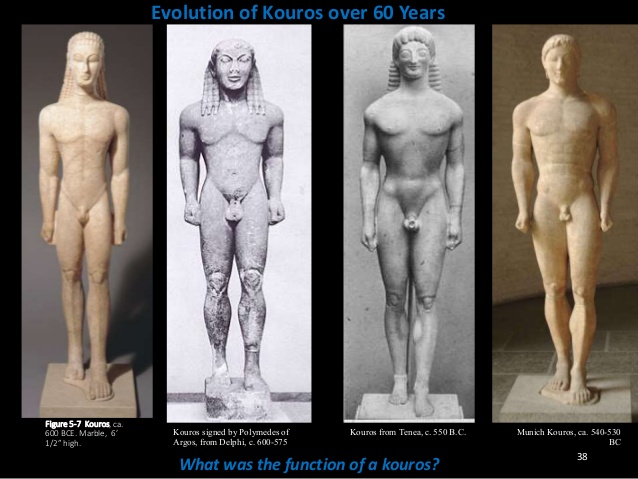 The story of this evolution reveals the unique contribution to art and to western art of its concentration on the human form, No other ancient artistic tradition in any other ancient culture was so devoted to the human form as was the Greek culture. Here in this one artistic choice is a major clue as to the enormous influence of Ancient Greek art on the whole 3000 years of Western art that begins here in Greece.
The story of this evolution reveals the unique contribution to art and to western art of its concentration on the human form, No other ancient artistic tradition in any other ancient culture was so devoted to the human form as was the Greek culture. Here in this one artistic choice is a major clue as to the enormous influence of Ancient Greek art on the whole 3000 years of Western art that begins here in Greece.
SUGGESTED READING IN HONOUR
If you are following our lectures with reading in Honour, chapter 4 on the Greeks will be the appropriate reading for the next 3 weeks of lectures. You can skip chapter 3, or enjoy it for your own benefit.
The best general introduction to Greek culture is this wonderful book from Edith Hall.

Edith Hall,
Introducing the Ancient Greeks: From Bronze Age Seafarers to Navigators of the Western Mind,
W. W. Norton & Company; 1 edition (June 16, 2014),
ISBN 0393239985
5
Week 5: Wednesday, November 9, 2022
Golden Age Greece
Week 5
Percy Bysshe Shelley: "The period which intervened between the birth of Pericles and the death of Aristotle, is undoubtedly, whether considered in itself or with reference to the effect which it has produced upon the subsequent destinies of civilized man, the most memorable in the history of the world.”
Golden Age Greece: Athens, 450-399 (death of Socrates). With the threat from the east gone, Athens begins a fifty year period under the brilliant statesman Pericles (495-429 BC) during which time the Parthenon was built on the Acropolis and the city becomes the artistic, cultural and intellectual as well as commercial center of the Hellenic world, attracting all sorts of smart and interesting people and taking command of the other Greek states. Continuing their war against the Persians they liberate the Ionian Greek cities of Asia Minor and the Aegean islands.
RECOMMENDED READING
If you would like to read one general historical introduction to the Greeks, here is the one to get.

Edith Hall,
Introducing the Ancient Greeks: From Bronze Age Seafarers to Navigators of the Western Mind,
W. W. Norton & Company; 1 edition (June 16, 2014),
ISBN 0393239985
6
Week 6: Wednesday, November 16, 2022
The Parthenon
Week 6
- Order
- Unity
- Beauty
- Perfection
- Communal order; universal order, the beauty of order
- How to achieve a vision of order?
- Create a physical embodiment of order.
RECOMMENDED READING
For tonight's lecture, see pages 126-137 in Honour:
THANKSGIVING NEXT WEEK NO CLASS
7
Week 7: Wednesday, November 30, 2022
The Age of Alexander
Week 7
The Age of Alexander refers to that two or three century period after the execution of Socrates (399) in Athens, the end of democracy in a sense, and the new age coming that will be dominated by that new state to the west: Rome. This period was viewed by the 19th Century art critics as a period of decline, a period when the high ideals of Golden Age Athens were jettisoned and new baser values of an age of dictators arose. A new culture in new centers such as Greek Alexandria would raise up with new values. One of the things you will all notice about this art, called "Hellenistic" is a new realism. The quest for the perfect balanced view of the perfect human being is now given up in favor of an intense new realism and emotionalism. And the new intense feelings will be especially evident in the sexy or violent poses of many of the most famous works of this period. You have two examples here: the Laocoön and His Sons group of figures now in the Vatican Museum, and this sleeping faun (satyr) called the Barberini Faun in Munich. They both exhibit a kind of intensity -- one violent, the other a beckoning sexiness.
RECOMMENDED READING
For Hellenistic art in Honour, see chapter five, starting on page 165.
8
Week 8: Wednesday, December 7, 2022
The Art of Rome
Week 8
Pliny, Ancient Rome's most important historian concerning the arts, recorded that nearly all the forms of art – sculpture, landscape, portrait painting, even genre painting – were advanced in Greek times, and in some cases, more advanced than in Rome. Though very little remains of Greek wall art and portraiture, certainly Greek sculpture and vase painting bears this out. These forms were not likely surpassed by Roman artists in fineness of design or execution. As another example of the lost "Golden Age", he singled out Peiraikos, "whose artistry is surpassed by only a very few ... He painted barbershops and shoemakers’ stalls, donkeys, vegetables, and such, and for that reason came to be called the 'painter of vulgar subjects'; yet these works are altogether delightful, and they were sold at higher prices than the greatest paintings of many other artists.” The adjective "vulgar" is used here in its original definition, which means "common". The Greek antecedents of Roman art were legendary. In the mid-5th century BC, the most famous Greek artists were Polygnotos, noted for his wall murals, and Apollodoros, the originator of chiaroscuro. The development of realistic technique is credited to Zeuxis and Parrhasius, who according to ancient Greek legend, are said to have once competed in a bravura display of their talents, history's earliest descriptions of trompe l’oeil painting. In sculpture, Skopas, Praxiteles, Phidias, and Lysippos were the foremost Greek sculptors. It appears that Roman artists had much Ancient Greek art to copy from, as trade in art was brisk throughout the empire, and much of the Greek artistic heritage found its way into Roman art through books and teaching. Ancient Greek treatises on the arts are known to have existed in Roman times, though are now lost. Many Roman artists came from Greek colonies and provinces. Below see the beautiful Villa of Mysteries wall paintings in Pompeii some of the most brilliant of all ancient wall painting: fresco.
RECOMMENDED READING
Roman art in Hugh Honour begins on page 179.
9
Week 9: Wednesday, December 14, 2022
The Art of Early Christians
Week 9
The beginnings of an identifiable Christian art can be traced to the beginning of the third century after Constantine gives out the Edict of Milan in 313. Considering the Old Testament prohibitions against graven images, it is important to consider why Christian art developed in the first place. The use of images will be a continuing issue in the history of Christianity. The best explanation for the emergence of Christian art in the early church is due to the important role images played in Greco-Roman culture. As Christianity gained converts, these new Christians had been brought up on the value of images in their previous cultural experience and they wanted to continue this in their Christian experience. For example, there was a change in burial practices in the Roman world away from cremation to inhumation. Outside the city walls of Rome, adjacent to major roads, catacombs were dug into the ground to bury the dead. Families would have chambers or cubicula dug to bury their members. Wealthy Romans would also have sarcophagi or marble tombs carved for their burial. The Christian converts wanted the same things. Christian catacombs were dug frequently adjacent to non-Christian ones, and sarcophagi with Christian imagery were apparently popular with the richer Christians. See below the sarcophagus of the Prefect of Rome Junius Bassus who died in 359 AD. Scholars believe that he converted to Christianity shortly before his death accounting for the inclusion of Christ and scenes from the Bible. This fine work of sculpture shows you the state of ancient classical sculpture in the later 4th century.
RECOMMENDED READING
Hugh Honour covers early Christian art in chapter 7, starting on page 288.
10
Week 10: Wednesday, December 21, 2022
The Art of the Northern Kingdoms
Week 10
The fall of Rome took place over several hundred years. This took place during the 400's and 500's. In the past, historians have viewed the fall of Rome is a horrible catastrophe. But now in the 21st Century, many historians have begun to consider the positive values that emerged in the post Roman period. One thing that happened was that new political units, new kingdoms emerged. The Franks, the kingdoms of the Anglo-Saxons, the kingdoms of the Visigoths, all created new political units in France Spain and England. These new kingdoms had new values, new capitals, and new art. So this week we will look at the art of what is sometimes called the "Dark Ages" but was in reality a very creative period with fascinating new artistic styles.
RECOMMENDED READING
Hugh Honour does not have a specific chapter on the art of the Northern Kingdoms. There is some material in his chapter on early Christian art.
CHRISTMAS VACATION NEXT TWO WEEKS
All
Week 1: Wed., Oct. 12, 2022
The Necessity of Art
Week 1
Human beings cannot live without art. They never have. The caves at Lascaux date back to possibly 30,000 years BC. They demonstrate that before agriculture, before the domestication of animals, people on earth created works of art. At Goeblecki Tepe, at Skara Brae on the Orkney Islands, or in the Egyptian desert, all over the world at all times, human beings have turned to some kind of artistic expression of who they are. Our first records of human life comes from their art. All human beings have made art. Human beings live painful, difficult lives and art allows them to escape that pain as well as allowing them to find fulfillment, meaning and even a kind of mystical union with the forces of nature. Art is a human creation. It is part of the human world. Animals do not care about art with one exception: music. Cows love Bach and give more milk with Bach. Chickens hate rock and rap and produce speckled eggs showing their discomfort with the nasty loud noise of contemporary rap. Monkeys made art only for bananas. They did not really care about art. Art is of the human world.
Our thirty weeks will allow us to see what this artistic world looks like.
REQUIRED READING
We are offering this book title to you as a "Required" book, but of course if you're schedule does not allow more reading then you can save this for later. What the author has done, a Professor of Philosophy at Columbia University, so to write a short book of about 100 pages in which he attempts to tell you why we need art, what art does, and what the relationship is for the human being and the arts. It is the best all-around introduction to the field of aesthetics that anyone has written since Aristotle.
RECOMMENDED READING
If you want the book above just click on the icon of the book and it will take you to that book within the Amazon catalog.
We want one book that will serve us all year for general background to both art and history. There are tow very famous ones, Helen Gardner and H. W. Janson. Both Janson and Gardner have been used in universities for art surveys for decades and because of this the price and availability of both volumes has now surpassed 100$ for a new copy of either. And used copies are very hard to get because university undergraduates have snapped them up every year. So all of this brings us to Hugh Honour. Honour was a very great British art historian who lived most of his life in Italy. He wrote many good books and along the way he wrote one of the very best one-volume surveys of art that now turns out to be the best choice for us. It is beautiful, not outrageously overpriced, and available. I have printed a screen shot of the page from Amazon to point out that you must be careful. You do not want to "rent" the book. That is very cheap undergraduates. And as you can see there are many options in the price category. A brand new one is about 70$ and we just received several at the Institute and they were perfect. It is a very beautiful especially since it has on its cover the magnificent Simonetta Vespucci.
Week 2: Wed., Oct. 19, 2022
Art in the Ancient World: Egypt, Mesopotamia, India, and China
Week 2
The story that we will follow here these next ten weeks of Fall Quarter is the story of Western Art, that is, art that begins in Ancient Greece, continues on into Roman civilization and then on into Medieval Europe. But there are many important artistic traditions that anticipate the Western story by thousands of years. We will explore those other, older artistic traditions this week. It is a. fleeting moment to spend with such artistic richness, but it will possibly spark an interest in something you do not know, and you can return to it later. We do not know what is the oldest of Mediterranean artistic traditions. For a hundred years. we have assumed that art began in Sumer at something like 3000 BC. But with the discovery of Göbekli Tepe in Turkey in 1994 by Klaus Schmidt of the German Archaeological Institute in Turkey, those boundaries had to be moved back to ten thousand BC.
RECOMMENDED READING
For week two of History of Art, read the first 100pp of Honour.
Ancient Egypt, Mesopotamia, Minoans, India, China.
Week 3: Wed., Oct. 26, 2022
Early European Art
Week 3
The roots of all of Western art were laid down in the momentous invasions of the Indo-European peoples into the Mediterranean area in about 2000 BC. These invasions that we now refer to as the Indo-European Invasions brought a new people into the Mediterranean world, people with horses and chariots and a completely new culture. They came with chariots from the Ukraine and Russian steppe region. The culture they brought with them was the basis for the new societies in Greece, Italy, and Central Europe.
RECOMMENDED READING
Week 4: Wed., Nov. 2, 2022
The Art of Agamemnon and Nestor
Week 4
The earliest manifestation of the new Bronze Age invader culture is visible in the art of Mycenae (Agamemnon), Pylos (Nestor) and Troy (The treasure of Priam). All three of these ancient Greek city-states were established and rich by 1500 BC and all three are connected in the stories of the Trojan War which is often dated to something like 1200-1100 BC (same time as the Exodus). The art and culture of this world gives us a window into Ancient Greek culture before the Trojan War and before the Bronze Age Collapse. Eric Kline's date for the Bronze Age Collapse is in the 1100's and his book about it is entitled 1177, The Year Civilization Collapsed.

Eric H. Cline,
1177 B.C.: The Year Civilization Collapsed,
Princeton University Press; Revised edition (September 22, 2015),
ISBN 0691168385
A NOTE ON THE FALL OF TROY
In 2008, scientists Marcelo O. Magnasco and Constantino Baikouzis at Rockefeller University used clues in the text and astronomical data to attempt to pinpoint the time of Odysseus’s return from his journey after the Trojan War. The first clue is Odysseus’ sighting of Venus just before dawn as he arrives on Ithaca. The second is a new moon on the night before the massacre of the Suitors. The final clue is a total eclipse, falling over Ithaca around noon, when Penelope’s Suitors sit down for their noon meal. The seer Theoclymenus approaches the Suitors and foretells their death, saying, “The Sun has been obliterated from the sky, and an unlucky darkness invades the world.” The problem with this is that the ‘eclipse’ is only seen by Theoclymenus, and the Suitors toss him out, calling him mad. No one else sees the sky darken, and it is therefore not actually described as an eclipse within the story, merely a vision by Theoclymenus. Doctors Baikouzis and Magnasco state that “the odds that purely fictional references to these phenomena (so hard to satisfy simultaneously) would coincide by accident with the only eclipse of the century are minute.” They conclude that these three astronomical references “‘cohere’, in the sense that the astronomical phenomena pinpoint the date of 16 April 1178 BC” as the most likely date of Odysseus’ return. This dating places the destruction of Troy, ten years before, to 1188 BC, which is close to the archaeologically dated destruction of Troy VIIa circa 1190 BC.
The most illustrative of all the artistic creations of this very early Greek culture is the evolution over several hundred years of the standing nude figure of both men and women. But the male figure was more important and more widely created.
 The story of this evolution reveals the unique contribution to art and to western art of its concentration on the human form, No other ancient artistic tradition in any other ancient culture was so devoted to the human form as was the Greek culture. Here in this one artistic choice is a major clue as to the enormous influence of Ancient Greek art on the whole 3000 years of Western art that begins here in Greece.
The story of this evolution reveals the unique contribution to art and to western art of its concentration on the human form, No other ancient artistic tradition in any other ancient culture was so devoted to the human form as was the Greek culture. Here in this one artistic choice is a major clue as to the enormous influence of Ancient Greek art on the whole 3000 years of Western art that begins here in Greece.
SUGGESTED READING IN HONOUR
If you are following our lectures with reading in Honour, chapter 4 on the Greeks will be the appropriate reading for the next 3 weeks of lectures. You can skip chapter 3, or enjoy it for your own benefit.
The best general introduction to Greek culture is this wonderful book from Edith Hall.

Edith Hall,
Introducing the Ancient Greeks: From Bronze Age Seafarers to Navigators of the Western Mind,
W. W. Norton & Company; 1 edition (June 16, 2014),
ISBN 0393239985
Week 5: Wed., Nov. 9, 2022
Golden Age Greece
Week 5
Percy Bysshe Shelley: "The period which intervened between the birth of Pericles and the death of Aristotle, is undoubtedly, whether considered in itself or with reference to the effect which it has produced upon the subsequent destinies of civilized man, the most memorable in the history of the world.”
Golden Age Greece: Athens, 450-399 (death of Socrates). With the threat from the east gone, Athens begins a fifty year period under the brilliant statesman Pericles (495-429 BC) during which time the Parthenon was built on the Acropolis and the city becomes the artistic, cultural and intellectual as well as commercial center of the Hellenic world, attracting all sorts of smart and interesting people and taking command of the other Greek states. Continuing their war against the Persians they liberate the Ionian Greek cities of Asia Minor and the Aegean islands.
RECOMMENDED READING
If you would like to read one general historical introduction to the Greeks, here is the one to get.

Edith Hall,
Introducing the Ancient Greeks: From Bronze Age Seafarers to Navigators of the Western Mind,
W. W. Norton & Company; 1 edition (June 16, 2014),
ISBN 0393239985
Week 6: Wed., Nov. 16, 2022
The Parthenon
Week 6
- Order
- Unity
- Beauty
- Perfection
- Communal order; universal order, the beauty of order
- How to achieve a vision of order?
- Create a physical embodiment of order.
RECOMMENDED READING
For tonight's lecture, see pages 126-137 in Honour:
THANKSGIVING NEXT WEEK NO CLASS
Week 7: Wed., Nov. 30, 2022
The Age of Alexander
Week 7
The Age of Alexander refers to that two or three century period after the execution of Socrates (399) in Athens, the end of democracy in a sense, and the new age coming that will be dominated by that new state to the west: Rome. This period was viewed by the 19th Century art critics as a period of decline, a period when the high ideals of Golden Age Athens were jettisoned and new baser values of an age of dictators arose. A new culture in new centers such as Greek Alexandria would raise up with new values. One of the things you will all notice about this art, called "Hellenistic" is a new realism. The quest for the perfect balanced view of the perfect human being is now given up in favor of an intense new realism and emotionalism. And the new intense feelings will be especially evident in the sexy or violent poses of many of the most famous works of this period. You have two examples here: the Laocoön and His Sons group of figures now in the Vatican Museum, and this sleeping faun (satyr) called the Barberini Faun in Munich. They both exhibit a kind of intensity -- one violent, the other a beckoning sexiness.
RECOMMENDED READING
For Hellenistic art in Honour, see chapter five, starting on page 165.
Week 8: Wed., Dec. 7, 2022
The Art of Rome
Week 8
Pliny, Ancient Rome's most important historian concerning the arts, recorded that nearly all the forms of art – sculpture, landscape, portrait painting, even genre painting – were advanced in Greek times, and in some cases, more advanced than in Rome. Though very little remains of Greek wall art and portraiture, certainly Greek sculpture and vase painting bears this out. These forms were not likely surpassed by Roman artists in fineness of design or execution. As another example of the lost "Golden Age", he singled out Peiraikos, "whose artistry is surpassed by only a very few ... He painted barbershops and shoemakers’ stalls, donkeys, vegetables, and such, and for that reason came to be called the 'painter of vulgar subjects'; yet these works are altogether delightful, and they were sold at higher prices than the greatest paintings of many other artists.” The adjective "vulgar" is used here in its original definition, which means "common". The Greek antecedents of Roman art were legendary. In the mid-5th century BC, the most famous Greek artists were Polygnotos, noted for his wall murals, and Apollodoros, the originator of chiaroscuro. The development of realistic technique is credited to Zeuxis and Parrhasius, who according to ancient Greek legend, are said to have once competed in a bravura display of their talents, history's earliest descriptions of trompe l’oeil painting. In sculpture, Skopas, Praxiteles, Phidias, and Lysippos were the foremost Greek sculptors. It appears that Roman artists had much Ancient Greek art to copy from, as trade in art was brisk throughout the empire, and much of the Greek artistic heritage found its way into Roman art through books and teaching. Ancient Greek treatises on the arts are known to have existed in Roman times, though are now lost. Many Roman artists came from Greek colonies and provinces. Below see the beautiful Villa of Mysteries wall paintings in Pompeii some of the most brilliant of all ancient wall painting: fresco.
RECOMMENDED READING
Roman art in Hugh Honour begins on page 179.
Week 9: Wed., Dec. 14, 2022
The Art of Early Christians
Week 9
The beginnings of an identifiable Christian art can be traced to the beginning of the third century after Constantine gives out the Edict of Milan in 313. Considering the Old Testament prohibitions against graven images, it is important to consider why Christian art developed in the first place. The use of images will be a continuing issue in the history of Christianity. The best explanation for the emergence of Christian art in the early church is due to the important role images played in Greco-Roman culture. As Christianity gained converts, these new Christians had been brought up on the value of images in their previous cultural experience and they wanted to continue this in their Christian experience. For example, there was a change in burial practices in the Roman world away from cremation to inhumation. Outside the city walls of Rome, adjacent to major roads, catacombs were dug into the ground to bury the dead. Families would have chambers or cubicula dug to bury their members. Wealthy Romans would also have sarcophagi or marble tombs carved for their burial. The Christian converts wanted the same things. Christian catacombs were dug frequently adjacent to non-Christian ones, and sarcophagi with Christian imagery were apparently popular with the richer Christians. See below the sarcophagus of the Prefect of Rome Junius Bassus who died in 359 AD. Scholars believe that he converted to Christianity shortly before his death accounting for the inclusion of Christ and scenes from the Bible. This fine work of sculpture shows you the state of ancient classical sculpture in the later 4th century.
RECOMMENDED READING
Hugh Honour covers early Christian art in chapter 7, starting on page 288.
Week 10: Wed., Dec. 21, 2022
The Art of the Northern Kingdoms
Week 10
The fall of Rome took place over several hundred years. This took place during the 400's and 500's. In the past, historians have viewed the fall of Rome is a horrible catastrophe. But now in the 21st Century, many historians have begun to consider the positive values that emerged in the post Roman period. One thing that happened was that new political units, new kingdoms emerged. The Franks, the kingdoms of the Anglo-Saxons, the kingdoms of the Visigoths, all created new political units in France Spain and England. These new kingdoms had new values, new capitals, and new art. So this week we will look at the art of what is sometimes called the "Dark Ages" but was in reality a very creative period with fascinating new artistic styles.
RECOMMENDED READING
Hugh Honour does not have a specific chapter on the art of the Northern Kingdoms. There is some material in his chapter on early Christian art.
